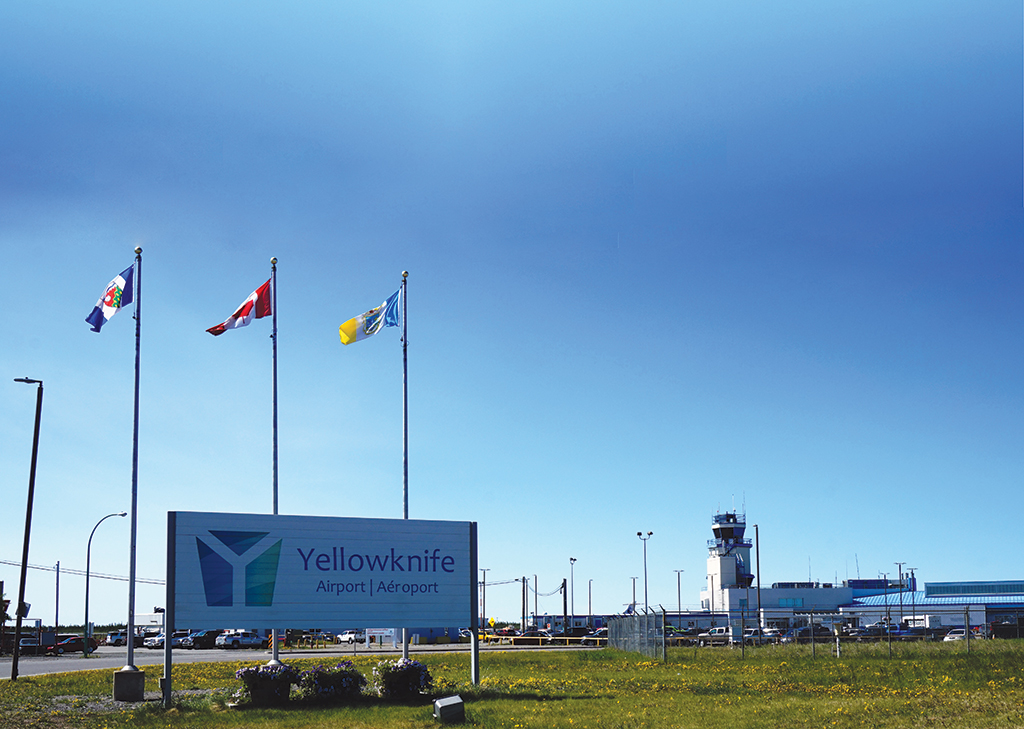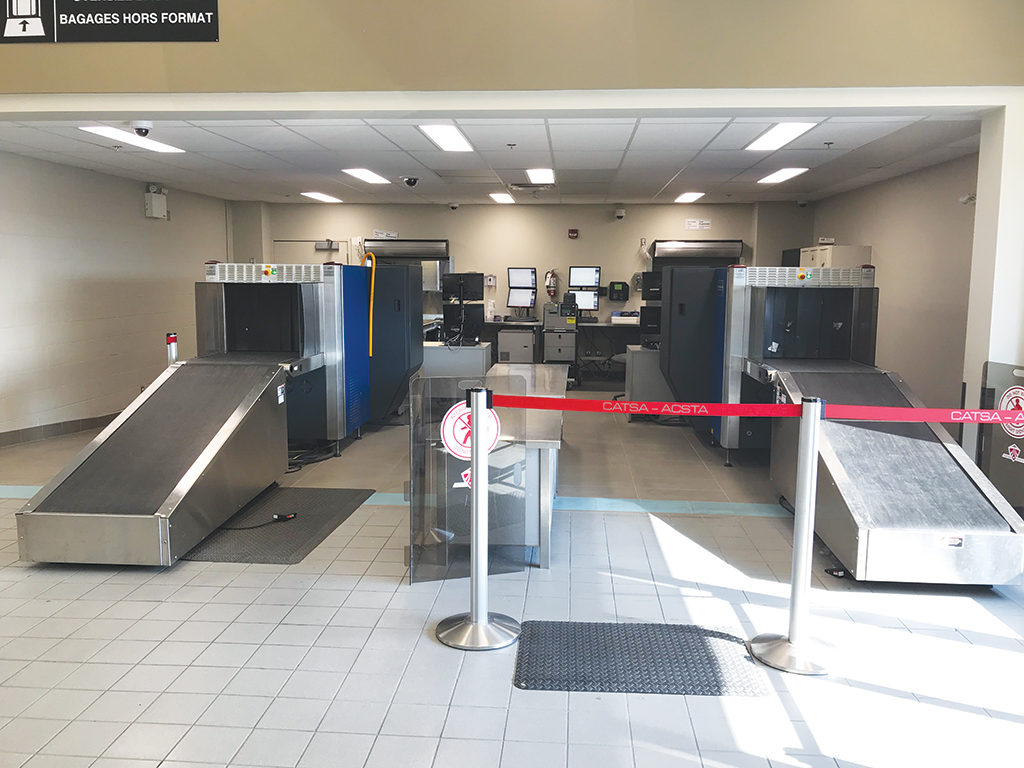

By Graham Chandler
You may not have noticed, but on Canada Day two years ago, a momentous change occurred at the Yellowknife Airport (YZF). But that in turn prompted many more updates, many of which you probably have noticed. That big 2017 change transformed the status of YZF from a funded line item within the Government of the Northwest Territories (GNWT) Department of Infrastructure to a self-sustaining entity. The new arrangement set up a revolving fund. Under it, all funds generated at the airport stay at the airport and are reinvested at the airport, so it operates just like most businesses and supports its own growth opportunities. The result has been positive. “The switch to a self-sustaining model has been very successful,” says Randy Straker, Acting Regional Airport Manager. “To date, revenues generated by the airport improvement fee and increased aeronautical fees have been consistent with projections and assumptions contained in the business plan. At this early stage of the revolving fund, the airport is on course for financial self-sufficiency under the current fees structure.” Much of Yellowknife Airport’s income is currently generated through aeronautical fees including landing, terminal, and aircraft parking fees. The airport improvement fee is also a significant revenue source and is used for capital projects exclusively. Non-aeronautical revenues include commercial leases, parking, and advertising. YZF hopes to supplement these. “Part of our 20-year plan will be to look at ways of developing non-aeronautical revenues,” says Straker. On the expenditure side, “Our primary expenditures fall under operations and maintenance as well as contracted services, such as security.”
“Over 575,000 passengers pass through YZF every year and that’s growing.”
Nationally Important Airport
YZF is a vital piece of Canadian infrastructure. It is the primary aviation gateway to communities in the North and plays a major role in supporting industry, tourism and the overall quality of life in the North. It is one of the 26 airports in Canada included in the National Airports System (NAS). Transport Canada defines the NAS as those strategic infrastructure assets essential to Canada’s air transportation system.
As such, the airport hosts extensive commercial activities that rely on quality aviation facilities and services. And non-aviation related businesses are attracted because of available land and ready access. Further, YZF services federal and territorial aviation needs associated with DND, forest fire fighting, medevac and charter aircraft operations and base facilities.
It all adds up to a lot of responsibility and it shows. Passenger traffic through YZF has more than doubled since the late 1980s and is expected to continue to grow faster than the national average forecast for the top 100 airports in Canada. Over 575,000 passengers pass through YZF every year and that’s growing. Forecasters attribute the increases to tourism – particularly the growing Asian market – and higher business travel demand, including mining personnel on shift changes.

And growth marches on. “Yellowknife Airport continues to serve more travellers,” says Straker. “Passenger numbers through the air terminal building grew by about four per cent last year.” Contributing to the gain has been new routes by
the regular airlines. For example, “Yellowknife Airport has established year-round non-stop service to Vancouver with Air Canada as well as a second seasonal direct flight,” he says. Indeed, YZF is a significant economic driver for the City of Yellowknife and the NWT overall. According to an earlier economic impact study leading up to the self-sustaining model implementation, more than 1,000 people are employed on and around airport lands doing aviation things and it supports a total of 2,000 jobs in a variety of sectors, when you consider the related economic impact. The study also reported that organizations based at the airport directly produced over $170 million in Gross Domestic Product (GDP), and activity at YZF contributed over $45 million in various taxes.
A Winning Strategy
To bolster and grow these numbers, YZF developed its change management strategy and business plan, reaching out to a number of key airport community stakeholders and the general public.
Feedback highlighted the need for active engagement with stakeholders and presentation of a clearly articulated vision for the future of the airport. Addressed were linkages to economic benefits that would be driven by future development at YZF. For example, to make YZF a destination point by way of terminal building renovations to make it more tourist friendly and provide a sense of place for those arriving in the NWT through YZF. This would include reviewing the costs and benefits of jet bridges to improve convenience for deplaning passengers especially in winter. Additional recommendations were for a non-stop connection to Vancouver both for residents and to encourage one-stop travel for tourists from Japan, China, and Europe; and more domestic cargo routes in the North out of the YZF hub. For the latter, improvement of YZF’s standing in the airfreight sector and developing a multimodal freight cargo facility for Northern cargo distribution were suggested.
Finally, a new business development focus was needed to help generate user benefits like enhanced efficiency in passenger processing, pre-camp screening, and cargo handling, for the resource sector.

Good Progress So Far
Many of the business plan’s recommendations are ongoing or complete. “Yellowknife Airport has made progress on several strategic improvements,” says Straker. “Including construction of a new and improved pre-board security screening area and an improved layout and screening process.” He says enhanced food and beverage services are now available in the pre-boarding departures lounge, along with increased capacity. And upgrades to the oversized baggage screening and hold baggage screening are now complete. To the completed list he adds, “Opening of ‘The Cabin’ gift shop inside the main terminal building, featuring a range of local craft items and other goods.” Last but not least, the design and geotechnical work for the new de-icing bay is well underway.
Around the airport, “There have been a few commercial developments at YZF since the revolving fund was established,” says Straker. As well as the upgrades to the general aviation area, and food and beverage in the pre-board departures lounge, demolition of the old mainte
nance garage and improvements to parking are now complete. “For the most part, YZF is still in the planning phase of further commercial developments and awaiting completion of the comprehensive 20-year master plan to help plan for the medium to long term.” He expects the master plan will be completed this summer.
Meanwhile for the upcoming 2019-20 fiscal year further investments are slated – subject to budgetary approval. According to the current business plan, space in the former airport fire hall is to be repurposed for airport operations and management offices, and second floor offices in the airport terminal building will be redeveloped for air carriers’ use. A welcome change will be completion of the centralized de-icing facility potentially with a renewed glycol retention pond liner. Airport and airfield improvements will include needed lighting system upgrades and fencing renewals, some airside mobile equipment upgrades, and capacity enhancements to the combined service building.
“Yellowknife Airport is always looking to boost tourism and create further economic opportunities,” says Straker. It’s very much a cooperative undertaking: “Consulting with many key stakeholders such as the Airline Consultative Committee, the YZF Economic Advisory Committee, City of Yellowknife, Yellowknife Chamber of Commerce, and Tourism work to enhance air service and expand connectivity in the North and beyond.”

Warm to Our Cold
A potentially lucrative business opportunity seen for Yellowknife Airport is developing the site as a world-class aircraft cold weather testing centre. “YZF has been working with the Yellowknife Airport Cold Weather Testing Group (CWT) to target international industry leaders by creating a video and brochure to be included in Destination Canada’s marketing program,” says Straker. The CWT Group is made up of the City of Yellowknife, the GNWT’s Industry,
Tourism, and Investment, NWT Tourism, and YZF. “Cold weather testing is a perfect example of how multiple agencies and vendors work together to produce material to target international aerospace leaders through the marketing of Destination Canada,” he says.
The concept has strong government support: “The [CWT] group’s goal is to ensure Yellowknife is recognized by global aerospace leaders as the number one
Arctic cold weather testing destination,” said Wally Schumann, Minister of Industry, Tourism and Investment in a recent sitting of the Legislative Assembly. “Cold weather testing offers significant opportunity and major economic benefits for the local economy. Visiting teams typically stay in the testing location for 30 to 90 days and often include between 30 to 70 professionals such as engineers, pilots and support staff. This could significantly increase revenue growth for Yellowknife Airport’s partners, and create an opportunity to diversify the Northwest Territories’ winter tourism markets by developing a new sector of business tourism.”
“Going forward, partnerships with different groups and agencies will be key to continued growth in traffic which in turn will drive improvements to the airport,” says Straker. “Consultation with groups such as the Airline Consultative Committee and the Economic Advisory Committee helps YZF determine the needs of the carriers, needs of businesses, as well as opportunities for economic development.”
“A key component of our future direction is completion of the 20-year master plan,” adds Straker. “The master plan process has been comprehensive and many stakeholder groups have been consulted.” Stay tuned for more changes when that comes out.

